Cowbell Bass Guitar (8/8)
Jan 20, 2019
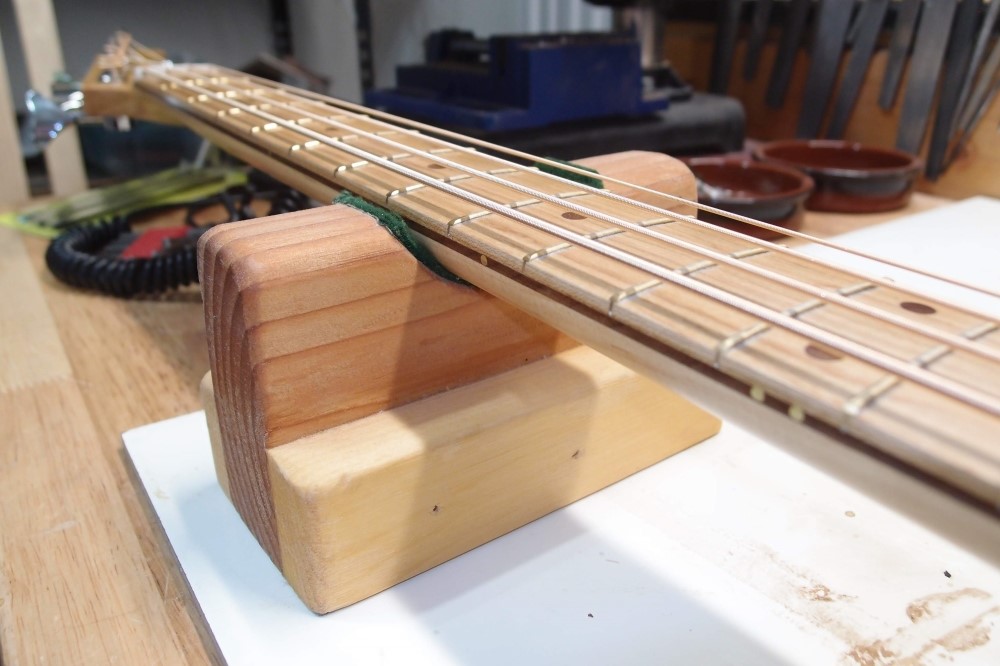
The Cowbell has been together now for a couple of weeks, so I can set it up. It actually needed very little. I just set the intonation my way -- 5th vs 17th -- and raised the action a tiny bit to my preference. The neck doesn't buzz anywhere, no need to touch the truss rod.
Above you can see the brass frets and matching side markers. The walnut stripe is the result of over-cutting the fretboard, but I think it looks great, and I may start doing it deliberately. This is one of the first fretboards I ever made. I hate to throw things away.
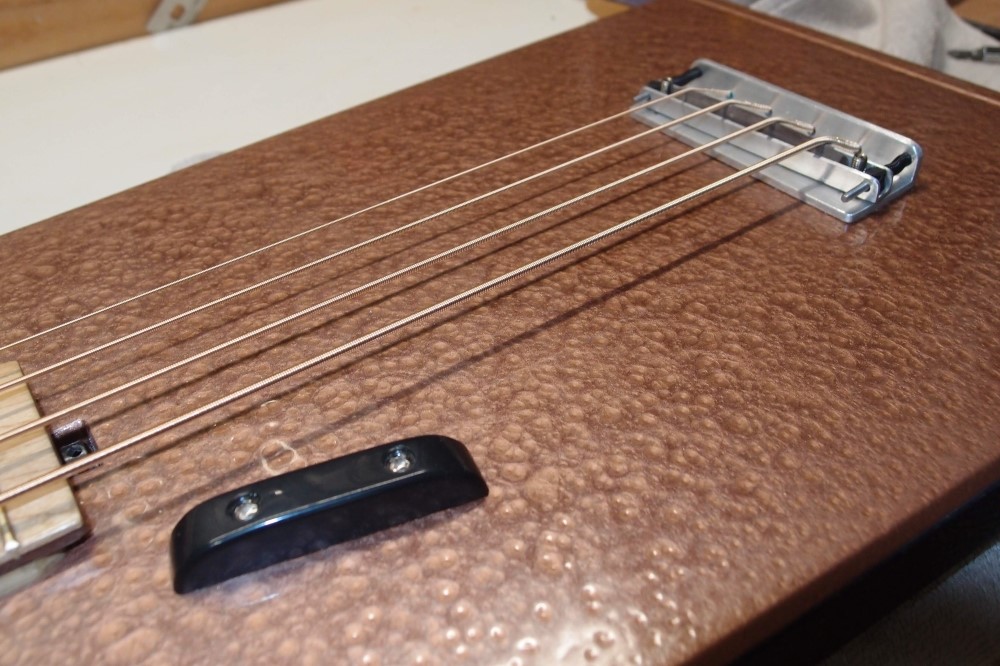
Some more detail: hammered paint, truss rod, and bridge. This bridge design worked out great. The piezo works perfectly. It is a standard under-saddle guitar piezo, sandwiched between the aluminum channel and a saddle carved from a scrap of 1/4" phenolic. The base plate is made from a section of 1-1/2" aluminum angle. The aluminum channel shows no sign of collapsing.
All of the aluminum was given a brushed look by sanding it. Small parts like string nuts polish up to a nice shine, but I haven't had the same results with larger parts, so I leave it with scratches. Aluminum is not nearly as hard as chrome, and the height screws will mark it up. Once you get everything adjusted, you can take the strings off and sand out the marks.
The strings are Fender bronze acoustics. These turn out to have a steel core and might tickle a magnetic pickup, but I haven't tried it. They are very bright, and I ended up modifying the tone control to cut down on the finger noise. The piezo sounds remarkably like a magnetic pickup now. The combination of active and passive tone controls give it a very wide range.

The neck mounting. The 32" scale neck is Radiata pine, which so far has proven to be perfectly strong and stable. It is also quite attractive, and lightweight compared to maple. The fretboard is maple, maybe the first one I ever made. I have a super-cheap build in the works, I think I will do another Radiata neck for that.
The body is pure Danelectro construction - masonite over plywood with Tolex edge binding. It looks pretty metallic, doesn't it? The 'handle' of the cowbell gets in the way of the highest frets, but I don't care about that. The offset strap button is completely out of the way, and the instrument balances on a strap as though it had a horn.
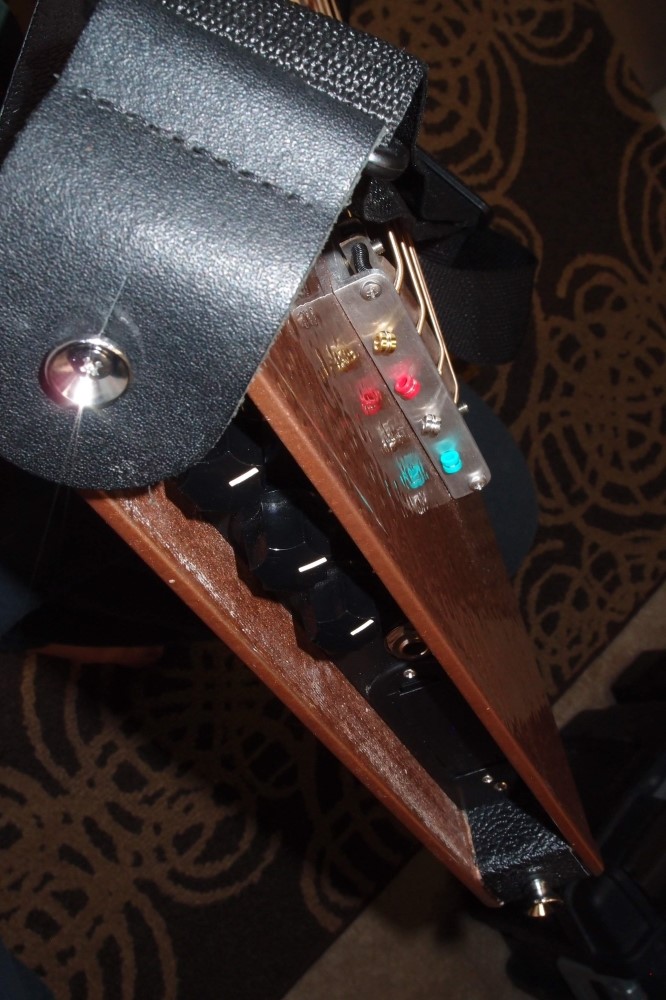
An upskirt of the electronics. Everything works perfectly. The controls are bass boost, treble cut, and volume. I think in a short time you could learn to work them by feel alone. This is my first pure-piezo full-sized bass, it really doesn't function without a battery, although it does have a backup mode.
Look at the reflection in the paint. This hammered paint comes out of the can this way, and then it really needs nothing. This is probably the easiest finish I have ever done. Next time, I would lay down a coat of primer/sealer first, which would save on paint, so you could probably get several guitars from one can. This hammered paint comes in a number of colors and is worth looking into.
Also another angle on the bridge. A bridge like this is actually not difficult to build, you can get everything from Home Depot. A piece of maple or acrylic will do for the saddle. A scrap of any tropical hardwood would also do. This bridge adjusts for height and intonation almost like a standard Fender bridge.
I used a set of GraphTech piezo saddles on a previous build. Those work great, but they are very expensive, and I have been trying for several years to figure out how to make inexpensive piezo elements work. I now have several different designs that all work well. Note that regardless of what kind of piezo you use, you need an active impedance buffer, or it will sound like crap.
This bass was built as a testbed for a number of kooky ideas that I decided to combine into a single instrument. It is also something of a joke - "More Cowbell!" For those origins, it is actually a really good instrument. It plays well, balances well, looks good, and sounds great. This is probably the lowest-cost build I've ever done. The only splurge was the strings, about $15.
I've worn myself out, I'm going to bed.
Jan 21, 2019
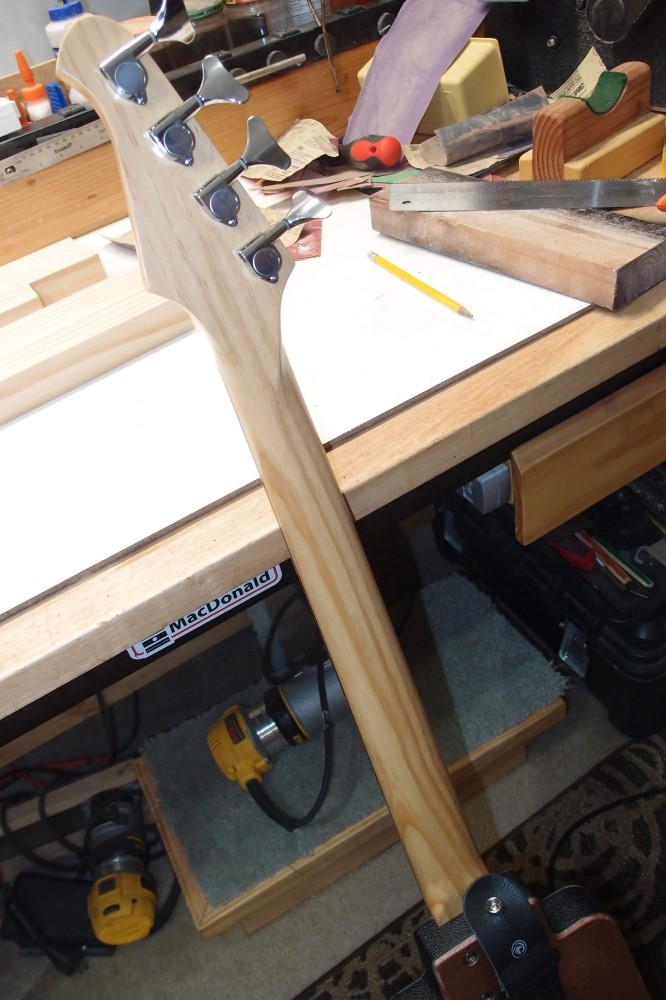
This is the pine neck of the Cowbell. I am just more and more pleased with this piece. It is strong and light and attractive. This wood is readily available, easy to work, and inexpensive. I like the grain and color too.
When I made this neck, I cut it along the edge of the board, the left edge in the photo above. If anything, I straightened the grain.
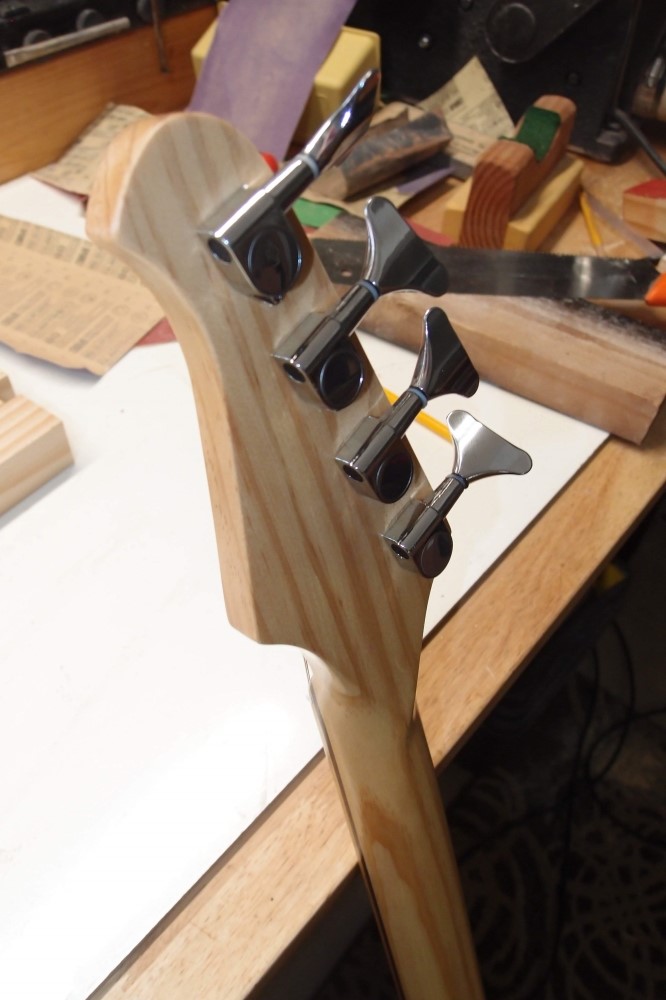
The glue joint is invisible except on the very end. You have to look a long time to find a piece of Radiata with even a small knot. I'm going to use it on an upcoming project instead of maple.
This result is totally unexpected. I figured this neck would twist right up under stress and I would be replacing it with a proper maple one. That's why I used all my oldest and cheapest parts on it and made the truss rod removable. Instead, I think it is quite nice and equal to anything maple.
The only thing I didn't like about this wood was a quick experiment with staining it. The grain disappeared, and it ended up looking like cardboard. That's actually par for the course with any kind of pine - you have to pre-treat it to get a nice result. ( Poplar is no better. ) You can use several coats of either pre-stain or natural stain to keep the wood from over-absorbing the color coats. It responds nicely to natural stain and Tung oil. This piece is finished in natural stain and Minwax spray poly.
The other two hardware store options for neck wood are red oak and poplar. Neither of these is a good choice. Oak is overly and unevenly hard, coarse-grained, and hard to work with. Poplar is soft and weak, even compared to this pine. Poplar is often quite unattractive as well.
With a little extra work, hard oak makes a fine fretboard. I wouldn't use Radiata for a fretboard, but it might actually work, it is pretty hard, no doubt hard enough to hold frets.
This wood has reached almost universal availability. Try it. You could conceivably build an entire guitar out of it.











Questions or Inquiries?
Just want to say Hello? Sign the .